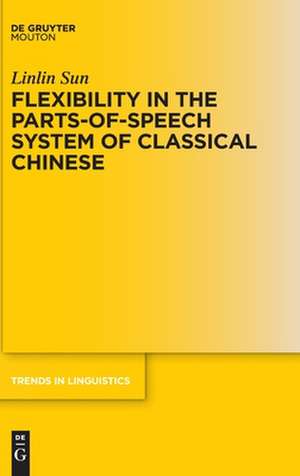Flexibility in the Parts-of-Speech System of Classical Chinese: ISSN, cartea 334
Autor Linlin Sunen Limba Engleză Hardback – 10 feb 2020
Din seria ISSN
- 18%
 Preț: 613.37 lei
Preț: 613.37 lei - 9%
 Preț: 615.52 lei
Preț: 615.52 lei -
 Preț: 216.27 lei
Preț: 216.27 lei - 9%
 Preț: 623.90 lei
Preț: 623.90 lei -
 Preț: 135.05 lei
Preț: 135.05 lei -
 Preț: 305.71 lei
Preț: 305.71 lei - 9%
 Preț: 1218.32 lei
Preț: 1218.32 lei -
 Preț: 161.64 lei
Preț: 161.64 lei -
 Preț: 105.14 lei
Preț: 105.14 lei -
 Preț: 158.75 lei
Preț: 158.75 lei - 9%
 Preț: 612.93 lei
Preț: 612.93 lei -
 Preț: 166.17 lei
Preț: 166.17 lei -
 Preț: 100.39 lei
Preț: 100.39 lei - 9%
 Preț: 612.70 lei
Preț: 612.70 lei - 9%
 Preț: 609.69 lei
Preț: 609.69 lei -
 Preț: 129.44 lei
Preț: 129.44 lei - 9%
 Preț: 618.30 lei
Preț: 618.30 lei -
 Preț: 218.45 lei
Preț: 218.45 lei - 9%
 Preț: 812.89 lei
Preț: 812.89 lei - 9%
 Preț: 605.28 lei
Preț: 605.28 lei -
 Preț: 339.78 lei
Preț: 339.78 lei - 9%
 Preț: 616.32 lei
Preț: 616.32 lei - 9%
 Preț: 1407.29 lei
Preț: 1407.29 lei -
 Preț: 119.58 lei
Preț: 119.58 lei -
 Preț: 124.94 lei
Preț: 124.94 lei -
 Preț: 149.89 lei
Preț: 149.89 lei -
 Preț: 227.45 lei
Preț: 227.45 lei -
 Preț: 165.33 lei
Preț: 165.33 lei -
 Preț: 143.65 lei
Preț: 143.65 lei -
 Preț: 220.59 lei
Preț: 220.59 lei -
 Preț: 331.88 lei
Preț: 331.88 lei -
 Preț: 216.17 lei
Preț: 216.17 lei -
 Preț: 228.32 lei
Preț: 228.32 lei -
 Preț: 227.04 lei
Preț: 227.04 lei -
 Preț: 148.05 lei
Preț: 148.05 lei -
 Preț: 188.67 lei
Preț: 188.67 lei -
 Preț: 293.39 lei
Preț: 293.39 lei -
 Preț: 240.57 lei
Preț: 240.57 lei - 9%
 Preț: 618.12 lei
Preț: 618.12 lei -
 Preț: 124.33 lei
Preț: 124.33 lei -
 Preț: 199.10 lei
Preț: 199.10 lei -
 Preț: 124.87 lei
Preț: 124.87 lei -
 Preț: 226.76 lei
Preț: 226.76 lei -
 Preț: 227.89 lei
Preț: 227.89 lei -
 Preț: 208.93 lei
Preț: 208.93 lei -
 Preț: 174.42 lei
Preț: 174.42 lei -
 Preț: 186.94 lei
Preț: 186.94 lei -
 Preț: 157.09 lei
Preț: 157.09 lei -
 Preț: 178.78 lei
Preț: 178.78 lei
Preț: 784.78 lei
Preț vechi: 1019.19 lei
-23% Nou
Puncte Express: 1177
Preț estimativ în valută:
150.17€ • 160.58$ • 125.21£
150.17€ • 160.58$ • 125.21£
Carte tipărită la comandă
Livrare economică 17 aprilie-01 mai
Preluare comenzi: 021 569.72.76
Specificații
ISBN-13: 9783110638431
ISBN-10: 3110638436
Pagini: 300
Ilustrații: 7 b/w ill., 15 b/w tbl.
Dimensiuni: 160 x 236 x 22 mm
Greutate: 0.6 kg
Editura: De Gruyter Mouton
Colecția ISSN
Seria ISSN
ISBN-10: 3110638436
Pagini: 300
Ilustrații: 7 b/w ill., 15 b/w tbl.
Dimensiuni: 160 x 236 x 22 mm
Greutate: 0.6 kg
Editura: De Gruyter Mouton
Colecția ISSN
Seria ISSN
Notă biografică
Linlin Sun, Johannes Gutenberg-Universität Mainz, Germany.
